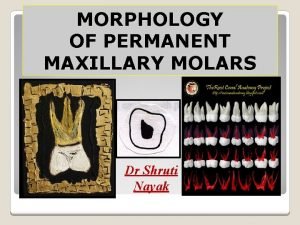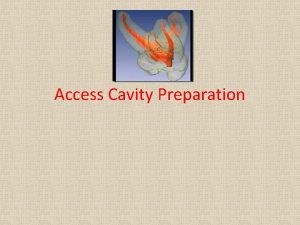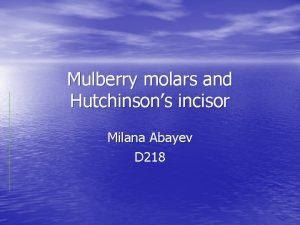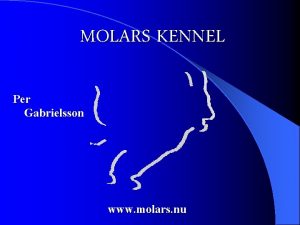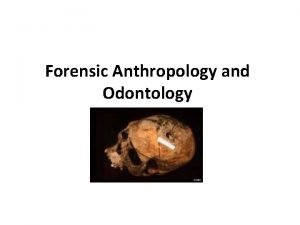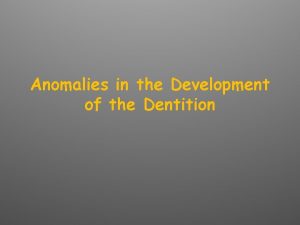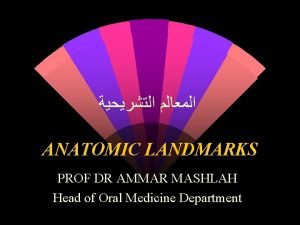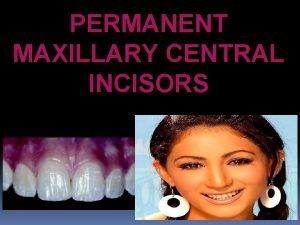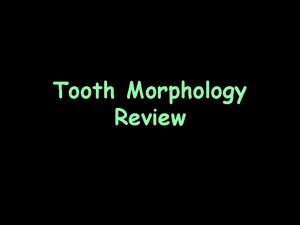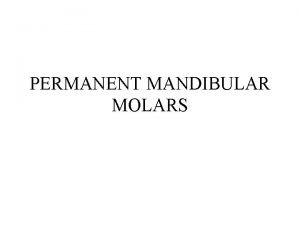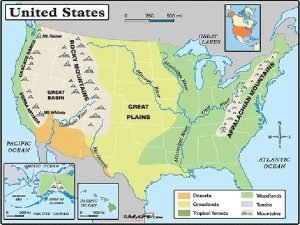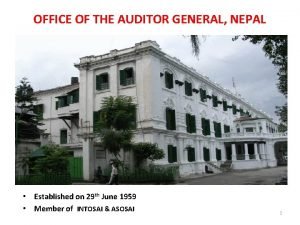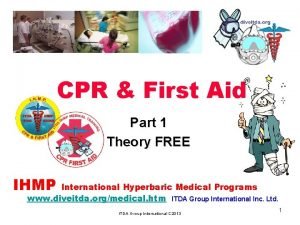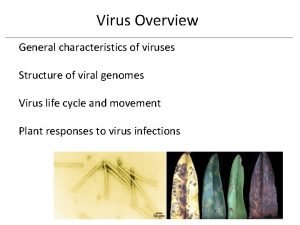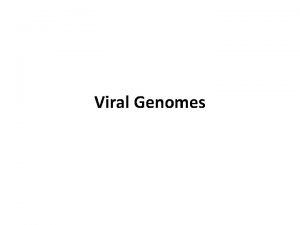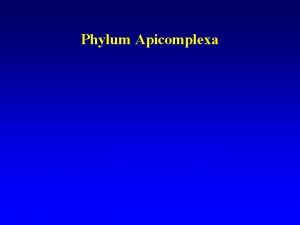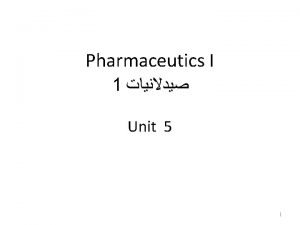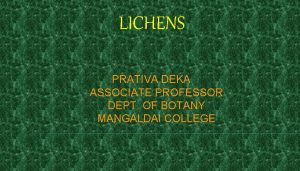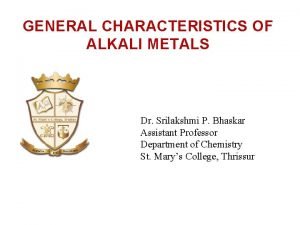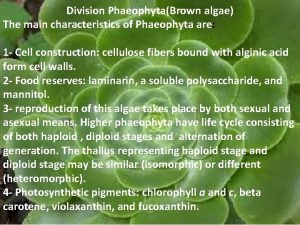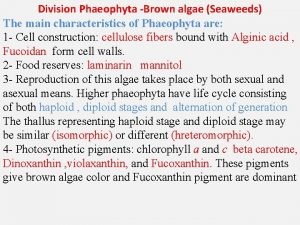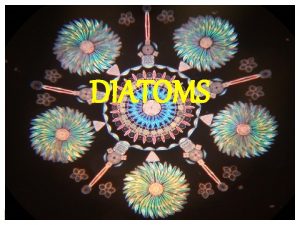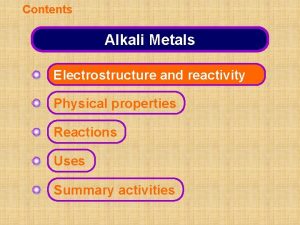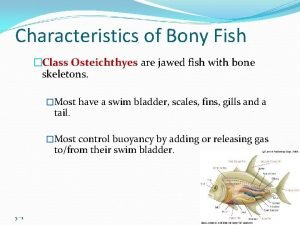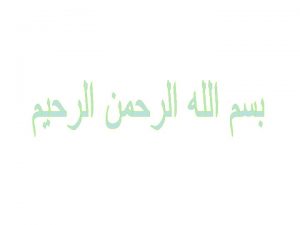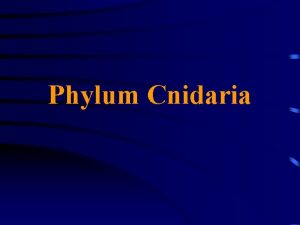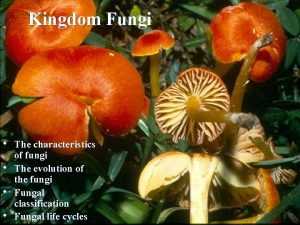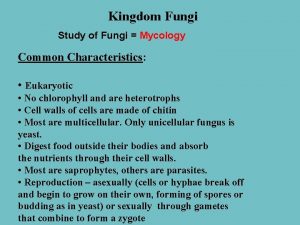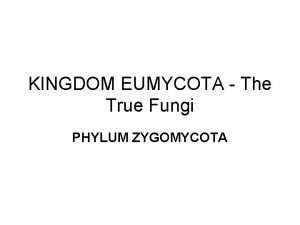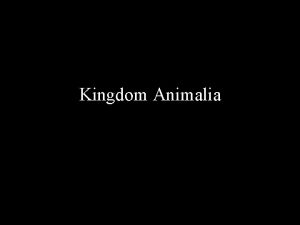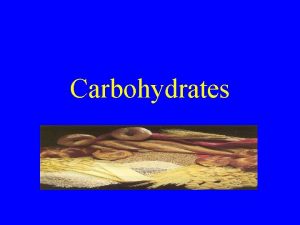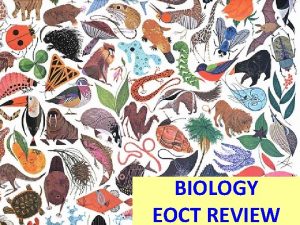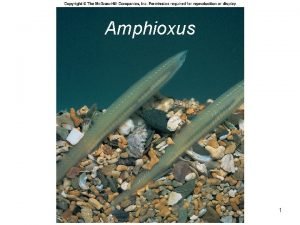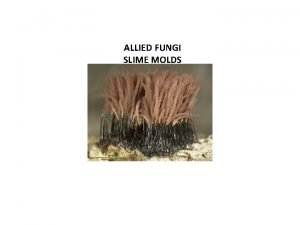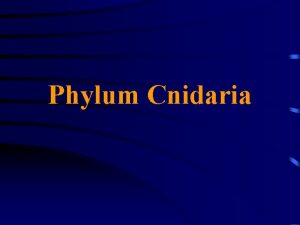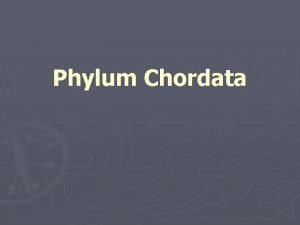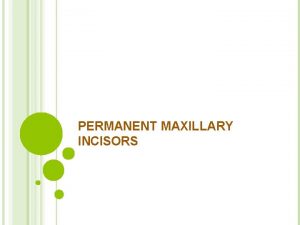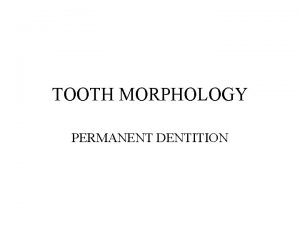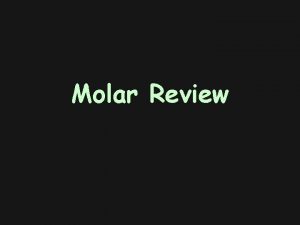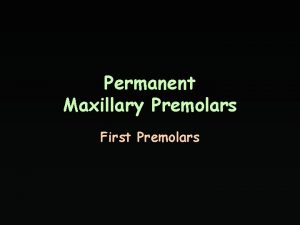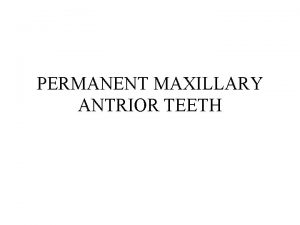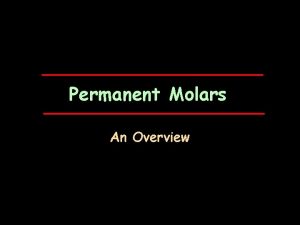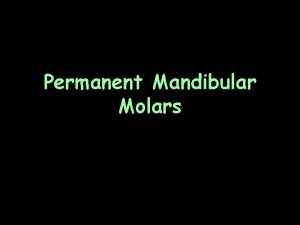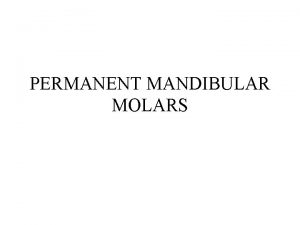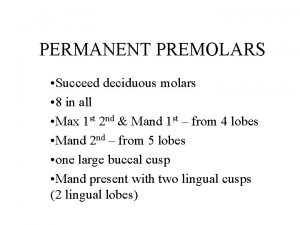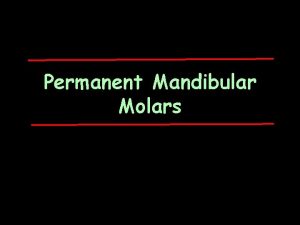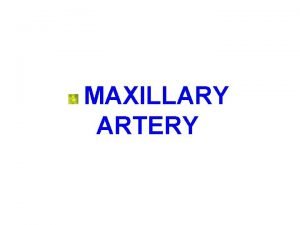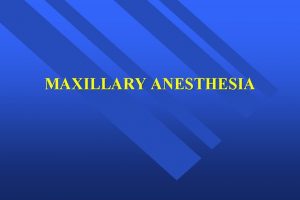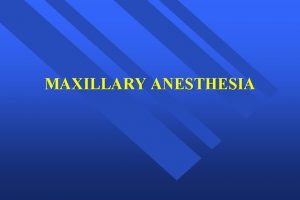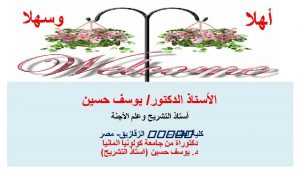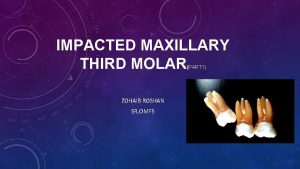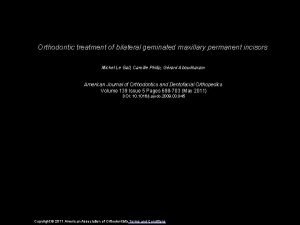Permanent Maxillary Molars Maxillary First Molar General Characteristics


















































- Slides: 50

Permanent Maxillary Molars

Maxillary First Molar

General Characteristics • Arch position: 6 th tooth from midline • Universal #3 and #14 • Mesially, contacts primary 2 nd molar and later 2 nd premolar • Largest tooth in maxillary arch • Least variable in anatomic form among max molars

General form: • Three roots: L, MB, DB • Slightly wider F-L than M-D • Trapezoidal geometric form F/L and proximal views • Occlusal view: rhomboidal geometric form (described as 5 -sided)

Development Timeline: • • Initial calcification: at birth* Enamel completed: 3 - 4 years Eruption: 6 - 7 years Root completed: 9 - 10 years

Facial view, mesial outline: • Mesial HOC at junction of occlusal and middle thirds • Outline relatively flat cervical to mesial HOC

Facial view, distal outline: • Distal HOC at middle third • Entire distal outline convex • Disto-occlusal angle more rounded than mesio-occlusal angle • Distal surface visible from this view

Facial view, cervical line: • Oftentimes a Vshape dip CE line pointing towards buccal bifurcation

Facial view, occlusal portion: • MB and DB cusps separated by buccal groove • MB cusp wider, DB cusp tip sharper* • ML cusp visible between MB and DB cusps

More facial… • Buccal groove usually ends midway O-C in a buccal pit • Bucco-gingival ridge runs horizontally, more prominent towards mesial • Facial HOC at cervical third

Lingual View • DLG separates larger ML cusp from smaller DL cusp • DLG oftentimes terminates in lingual pit • M-D width as wide or wider lingually than facially*

Lingual view… • Cusp of Carabelli* – Lingual surface of ML cusp – Varies in size: non-existent to prominent • Lingual HOC at middle third • Lingual root depression

Mesial view, facial outline: • Buccal HOC at cervical third (bucco-gingival ridge) • Facial surface fairly flat from HOC to cusp tip

Mesial view, lingual outline: • Lingual HOC at middle third • Overall convex curvature • Palatal root is lingual to the crown

Mesial view, occlusal outline: • Only MB and ML cusps visible • Mesial marginal groove usually present, midway of marginal ridge • Mesial contact area situated buccal to mesial groove, at junction of occlusal and middle thirds

Distal View • More of occlusal surfaces visible • All four cusp tips visible • Distal marginal groove usually present, midway of marginal ridge • Pronounced distal cervical crown/root concavity*

Distal view… • More of facial surface visible, but less of lingual surface (rhomboidal form) • Distal contact area located midway F-L, more cervical than mesial contact (middle third)

Occlusal View • Rhomboidal geometric form – Acute MB and DL corners – Obtuse DB and ML corners • 5 -sided (pentagonal) • Largest F-L dimensions of any tooth

Occlusal view… • F-L and M-D dimensions more similar* • M-D width as wide or wider lingually than facially* • Four major cusps: ML, MB, DL (largest to smallest) • Cusp triangle: MB, DB, ML (trigon)

Occlusal view… • Transverse ridge – Triangular ridges of MB and ML cusps • Oblique ridge – Triangular ridges of DB and ML cusps (distal cusp ridge? ) – About same height as the marginal ridges*

Occlusal view… • Three pits: mesial, central, distal • Three primary developmental grooves: central, buccal, distolingual • Four fossae: mesial, central, distolingual

Root Form • Root trunk with trifurcation: – Lingual root: • Largest, longest • Wider M-D than F-L* – MB root • 2 nd largest • Apex in line with MB cusp tip* – DB root • Smallest of three

Root form. . . • DB root area may have pronounced cervical concavity* • MB and DB root forms look like “plier handles” • MB root could have two pulp canals (70% possibility) • Root depression, lingual surface of lingual root

How To Tell Right From Left: • • Distolingual groove Cusp of Carabelli on ML cusp Broader MB root than DB root MB prominence of facial surface




Maxillary Second Molar

General Characteristics • • Arch position: 7 th from midline Universal #2 and #15 Wider F-L than M-D Similar to 1 st, except smaller • Smaller DL cusp

Development Timeline: • • Initial calcification: 2 1/2 - 3 years Enamel completed: 7 - 8 years Eruption: 12 - 13 years Root completed: 14 - 16 years

Facial View • Narrower M-D than 1 st • MB cusp larger than DB • Buccal groove more distally than 1 st • MB root tip in line with buccal groove*

Lingual View • Smaller DL cusp than 1 st • Lingual groove more distally located • No Cusp of Carabelli

Mesial and Distal Views • Similar to 1 st except shorter O-C • Facial HOC at cervical third • Lingual HOC at middle third

Occlusal View • Narrower M-D than F-L • Tapers lingually • Two major crown forms: - Rhomboidal - Heart-shaped (diminished DL cusp)

Root Form • MB and DB roots closer than 1 st • MB apex in line with buccal groove* • No lingual root depression

How To Tell First From Second: • Occlusal view of first less rhomboidal than second • Cusp of Carabelli only on first • M-D and F-L dimensions more similar with first, narrower M-D with second*

First from second. . . • MB root apex in line with MB cusp tip with first, in line with buccal groove with second*

Maxillary Third Molar

General Characteristics • • Arch position: 8 th from midline Universal #1 and #16 No distal contact area Only maxillary tooth that has single opposing tooth* • Smallest of all molars shortest O-C dimension of any tooth*

Development Timeline: • • Initial calcification: 7 - 9 years Enamel completed: 12 - 16 years Eruption: 17 - 21 years Root completed: 18 - 25 years

Crown Form • Most variable of maxillary posteriors • Heart-shape most common • Diminished or absent DL cusp • Still wider F-L than M-D • Occlusal table more constricted • No distal contact wear facet

Root Form • Three roots, partially or fully fused • Roots much shorter than 1 st and 2 nd, crown: root ratio closer to 1: 1 • Roots shorter than any other tooth (other than mandibular 3 rds)

How To Distinguish a Third: • Shorter root: Crown to root ratio nearly 1: 1* • Roots usually fused • More supplemental occlusal grooves* • Heart-shape occlusal outline, narrower occlusal table

How To Tell Right From Left: • • MB root larger than DB root MB prominence of facial surface DLG, if present Contact area wear facet only on mesial






 Maxillary 1st molar occlusal anatomy
Maxillary 1st molar occlusal anatomy Maxillary first molar oblique ridge
Maxillary first molar oblique ridge Definition of cavity preparation
Definition of cavity preparation Hutchinson's incisor
Hutchinson's incisor Grå schäfer kennel
Grå schäfer kennel Differences between the male and female skeleton
Differences between the male and female skeleton Who wore human molars as cufflinks
Who wore human molars as cufflinks Mulberry molars
Mulberry molars Halterman appliance
Halterman appliance الفرق بين radiolucent و radiopaque
الفرق بين radiolucent و radiopaque Crest of curvature of central incisor
Crest of curvature of central incisor Lingual pits
Lingual pits Largest cusp of mandibular first molar
Largest cusp of mandibular first molar First permanent english colony
First permanent english colony Planos en cinematografia
Planos en cinematografia Where did general lee surrender to general grant?
Where did general lee surrender to general grant? Function of auditor general of nepal
Function of auditor general of nepal General first aid
General first aid Rainsford first realizes he is going to be the prey when
Rainsford first realizes he is going to be the prey when General characteristics of viruses
General characteristics of viruses General characteristics of viruses
General characteristics of viruses Black water fever
Black water fever Interfacial properties of suspended particles ppt
Interfacial properties of suspended particles ppt Characteristics of lichens
Characteristics of lichens Fungus characteristics
Fungus characteristics Order of mobility of alkali metal ions
Order of mobility of alkali metal ions General characteristics of phaeophyta
General characteristics of phaeophyta Phaeophyta life cycle
Phaeophyta life cycle Characteristics of diatoms
Characteristics of diatoms General characteristics of alkali metals
General characteristics of alkali metals Osteichthyes characteristics
Osteichthyes characteristics Characteristics of renaissance criticism
Characteristics of renaissance criticism General characteristics of cell
General characteristics of cell Pathogenisis
Pathogenisis Phylum cnidaria general characteristics
Phylum cnidaria general characteristics Mycelia and hyphae
Mycelia and hyphae Chytridiomycota examples
Chytridiomycota examples What are the characteristics of zygomycota
What are the characteristics of zygomycota Kingdom animalia cladogram
Kingdom animalia cladogram Basidiomycota rusts and smuts
Basidiomycota rusts and smuts General characteristics of arthropods
General characteristics of arthropods General characteristics of carbohydrates
General characteristics of carbohydrates General characteristics of cell
General characteristics of cell General characteristics of cell
General characteristics of cell General characteristics of protista
General characteristics of protista Amphioxus classification
Amphioxus classification Aphanoplasmodium
Aphanoplasmodium General rifling characteristics database
General rifling characteristics database General characteristics of plantae
General characteristics of plantae General characteristics of cnidaria
General characteristics of cnidaria 4 characteristics of chordates
4 characteristics of chordates

